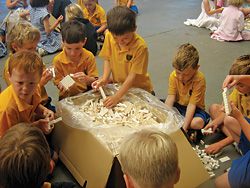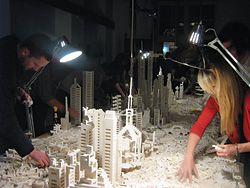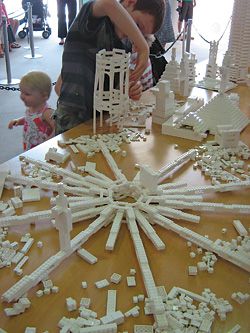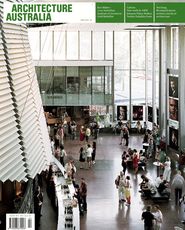
Groups of children assemble the loose pieces into structural elements.

Architects experiment and construct in the second stage at the Fremantle Architects Christmas Party.

The interactive public installation at the State Art Gallery of Western Australia. At every stage, there was a concerted effort to explore alternatives to traditional towers.
Children, architects and Lego combined in a three-stage event in Perth exploring the ephemeral, intuitive nature of building in Lego.
The Fremantle Architects Christmas Party has been an annual event for the past twenty years. Legend has it that it was initiated by a small group of established local architects who would meet regularly at a local watering hole. The creative hub of Fremantle and the number of architects that it supports have grown significantly since those early days, but the Christmas party still provides a vehicle to unite all in celebration.
Last year, Kerry Hill Architects hosted the party, the focus of which was 60,000 pieces of white Lego. Inspiration was drawn from Icelandic/Danish artist Olafur Eliasson’s The Cubic Structural Evolution Project 2004, an interactive installation using white Lego. Eliasson describes his installations as “constructions”, thus creating an association with the creation of environments, not with architecture. Yet many architects have fond childhood memories of Lego, so it was an intuitive decision to bring them together again.
A monochromatic white palette emphasizes composition of form, scale and chiaroscuro and the constructions erected by the architects during a four-hour period were a testimony to this principle. It was liberating to see that some architects experimented with assembling the Lego just as one would experiment with any building material. A strength of our profession is to seek innovation, by questioning and challenging established conventions and traditions and by employing simple materials to create something extraordinary. All of this was apparent from the collection of constructions that emerged from the evening and the inevitable dominance of tower constructions.
In preparation for the event, 200 primary school children were involved in a one-day exercise to assemble the loose pieces. In an open covered area, the children were questioned on what the built environment meant to them and shown a series of “architectural” projects that were beyond the ordinary and abstractly inspired by nature. Over half-hour periods the children created elements that were then added to a one-by-two-metre rectangle drawn on the ground: the boundaries of a city. The four-to-six-year-old group provided the most interesting and non-conventional built forms, while the tendency for tower constructions prevailed in the older age groups. The oldest age group was challenged with exploring non-traditional Lego construction techniques. The exercise with the children was dynamic, and the ephemeral nature of the Lego was realized when towering assemblages collapsed, reducing a major portion of the city to rubble. Components of the towers survived, allowing them to be re-erected within moments. These particular components were reused by the architects and then the public.
After both events, the Lego structures were disassembled into components and transported to their next destination. At the State Art Gallery of Western Australia they formed the basis of an interactive public installation for eight days. To provide inspiration and move away from predictable towers, there was an attempt to provide “constructions” that did not employ conventional horizontal/vertical stacking techniques.
Visiting the art gallery on three subsequent occasions, it was wonderful to see that the installation was popular and a hive of activity. It was encouraging to observe the interaction between parent and child and their complete immersion in assembling bricks. Over 2,000 children participated in the event, which ran in two-hour slots over the eight-day period. The constraint of 60,000 bricks facilitated a continually changing landscape of constructions.
Lego constructions are ephemeral and their assemblage is intuitive and playful. Lego remains and will continue to be a great leveller that unites people in play, thus reinforcing the fundamental philosophy of development through play.
Suzanne Bosanquet is an architect with Kerry Hill Architects. She was the organizer of the Lego event.















